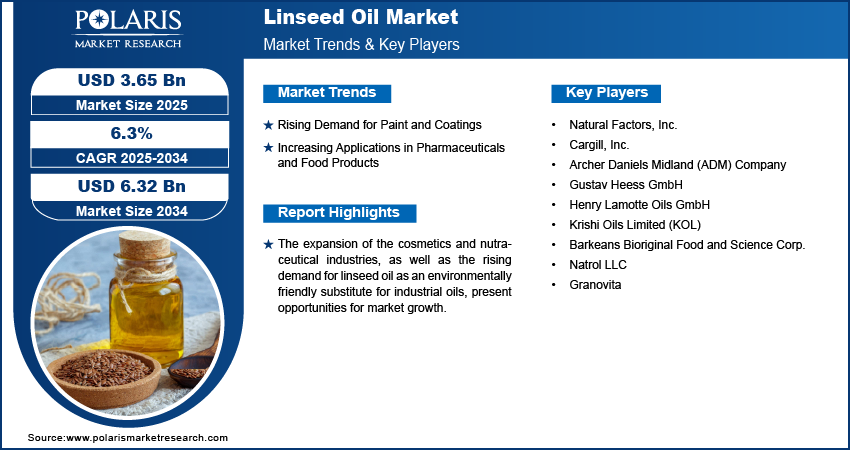Linseed Oil Market Gaining Traction Amid Rising Demand from Paints, Coatings, and Nutraceutical Industries

The linseed oil market is witnessing steady growth as demand surges across various industrial and consumer applications. Linseed oil, derived from dried, ripened seeds of the flax plant, is rich in omega-3 fatty acids and valued for its quick-drying properties. It is widely used in paints and coatings, wood finishing, putty production, and dietary supplements. The market is projected to grow steadily over the next decade, fueled by the global shift toward sustainable and bio-based products.
The linseed oil market size is expected to reach USD 6.32 billion by 2034, according to a new study by Polaris Market Research.
Market Overview
Linseed oil, also known as flaxseed oil, is available in various forms, including raw, boiled, and polymerized types. It serves as a crucial ingredient in industrial formulations, especially in paints, varnishes, inks, and linoleum flooring, due to its drying and bonding characteristics. Additionally, the rising popularity of natural health supplements has driven demand for cold-pressed linseed oil in the nutraceutical and cosmetic sectors.
Key Market Growth Drivers
One of the primary growth drivers of the linseed oil market is the increasing use of eco-friendly and biodegradable materials in industrial and consumer goods. Linseed oil is a renewable resource, making it a preferred choice in green manufacturing. The paints and coatings industry, in particular, is leveraging linseed oil as a low-VOC (volatile organic compound) alternative to synthetic oils and resins.
The growing trend of healthy living and increased awareness about the health benefits of omega-3 fatty acids have also propelled the use of linseed oil in dietary supplements and personal care products. It is used in skin moisturizers, hair oils, and anti-inflammatory formulations, particularly in Europe and North America.
In the construction and furniture sectors, linseed oil is gaining traction as a natural wood preservative and finish, offering resistance to water and decay. As the demand for sustainable building materials increases, linseed oil’s role in the wood treatment market is becoming more significant.
𝐆𝐞𝐭 𝐄𝐱𝐜𝐥𝐮𝐬𝐢𝐯𝐞 𝐒𝐚𝐦𝐩𝐥𝐞 𝐏𝐚𝐠𝐞𝐬 𝐨𝐟 𝐓𝐡𝐢𝐬 𝐑𝐞𝐩𝐨𝐫𝐭: https://www.polarismarketresearch.com/industry-analysis/linseed-oil-market/request-for-sample
Market Challenges
Despite its benefits, the linseed oil market faces certain challenges. One key restraint is the susceptibility of linseed oil to oxidation and rancidity, which can limit its shelf life. The price volatility of raw flaxseed, influenced by climatic and geopolitical factors, can also affect production costs.
In industrial applications, synthetic alternatives with longer shelf lives and lower costs may restrict market growth, especially in price-sensitive regions. Moreover, regulatory challenges related to food-grade certification can impact the use of linseed oil in consumables.
Key Companies
Leading players in the linseed oil market are focusing on expanding their product portfolios and investing in research to improve oil stability and performance. These companies operate across verticals such as agro-processing, paint manufacturing, and health supplements, catering to the diverse applications of linseed oil.
- Natural Factors, Inc.
- Archer Daniels Midland (ADM) Company
- Cargill, Inc.
- Gustav Heess GmbH
- Henry Lamotte Oils GmbH
- Krishi Oils Limited (KOL)
- Barkeans Bioriginal Food and Science Corp.
- Natrol LLC
- Granovita
Linseed Oil Market Segmentation
By Application Type Outlook
- Pharmaceuticals
- Flooring
- Cosmetics
- Paints & Coatings
- Processed Food
- Others
By Production Process Type Outlook
- Enzyme Extraction
- Cold-Pressing
- Solvent Extraction
By Form Type Outlook
- Organic
- Refined
- Raw
Regional Analysis
Europe dominates the global linseed oil market, supported by high demand in the construction, cosmetics, and nutritional supplement industries. Countries such as Germany, France, and the Netherlands are leading consumers due to strong environmental regulations favoring bio-based products.
North America is another significant market, driven by growing health awareness and demand for organic personal care items. The U.S. also shows strong demand from the wood treatment and paint sectors.
Asia-Pacific is expected to witness the fastest growth over the forecast period, particularly in China and India, where rising industrial output and growing disposable incomes are increasing demand across multiple sectors.






